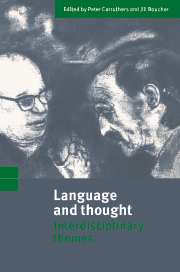Book contents
- Frontmatter
- Contents
- List of contributors
- Preface
- 1 Introduction: opening up options
- Part I Language, development and evolution
- Part II Language, reasoning and concepts
- Introduction to part II
- 6 Aphasic language, aphasic thought: an investigation of propositional thinking in an a-propositional aphasic
- 7 Representing representations
- 8 Magic words: how language augments human computation
- 9 The mapping between the mental and the public lexicon
- 10 Convention-based semantics and the development of language
- Part III Language and conscious reasoning
- References
- Author index
- Subject index
Introduction to part II
Published online by Cambridge University Press: 08 January 2010
- Frontmatter
- Contents
- List of contributors
- Preface
- 1 Introduction: opening up options
- Part I Language, development and evolution
- Part II Language, reasoning and concepts
- Introduction to part II
- 6 Aphasic language, aphasic thought: an investigation of propositional thinking in an a-propositional aphasic
- 7 Representing representations
- 8 Magic words: how language augments human computation
- 9 The mapping between the mental and the public lexicon
- 10 Convention-based semantics and the development of language
- Part III Language and conscious reasoning
- References
- Author index
- Subject index
Summary
The chapters in Part II all focus on the relationship between language, on the one hand, and concepts and reasoning abilities on the other – either in general, or within particular domains of thought, such as Theory of Mind (TOM). As previously, we first make some general introductory remarks, before saying something briefly to introduce each of the five chapters in Part II.
Anyone defending a strong form of cognitive conception of language will maintain, of course, that there is an intimate connection between language, concepts, and distinctive human reasoning abilities. At its strongest, their claim will be that the former (language) is both necessary and sufficient for the latter (McDowell, 1994). In weaker variants, the claim may only be that language is the vehicle of (and so a necessary but not a sufficient condition for) some types of concept, and/or some types of reasoning. Conversely, anyone defending a strong form of communicative conception of language will wish to maintain that our concepts and reasoning abilities are wholly independent of language. Such a person will claim that thinking is one thing, and encoding thought into language for purposes of communication is quite another. But here, too, a weaker variant of the position is possible. According to the supra-communicative conception of language (see chapter 1 above), thought and concepts are independent of language, and language is basically for the communication of thought; but it is also possible for language to enhance human cognitive powers, either via inner language, or by providing an external resource for cognition, as when one effects a complex calculation on paper, or writes out a shopping list.
- Type
- Chapter
- Information
- Language and ThoughtInterdisciplinary Themes, pp. 123 - 127Publisher: Cambridge University PressPrint publication year: 1998



